Congratulations on deciding to try your hand at peanut gardening! Peanuts are a great option for home gardeners who want to grow their own nuts. And since peanuts are relatively easy to grow, even novice gardeners can enjoy a successful harvest. You are embarking on an exciting and rewarding journey that will not only provide you with delicious, healthful peanuts but also a great sense of accomplishment. With a little bit of effort and patience, you can expect a bountiful harvest in a few short months. Remember to start small, choose a sunny spot, and ensure that the soil is well-draining. As you progress, you will learn the ins and outs of peanut gardening, and your skills will improve. Keeping reading to learn how to grow peanuts with this step-by-step guide!

Don’t worry if you are new to gardening, peanut plants are easy to grow and require minimal maintenance.
©iStock.com/White Bear Studio
What are Peanuts?
Peanuts (Arachis hypogaea) are legumes. They are native to South America but are now cultivated in many parts of the world, including the United States, China, and India. They are also known as groundnuts, earthnuts, and goobers. Peanuts grow underground and are actually a type of seed that develops in a pod. They have a brownish-red outer shell, and once harvested, the outer shell is removed to reveal the edible peanut. Peanuts are a nutrient-rich food that is high in protein, healthy fats, fiber, vitamins, and minerals. They can be eaten raw, boiled, or roasted and are used in a variety of culinary applications, such as peanut butter and peanut oil, and as a topping for salads and desserts.
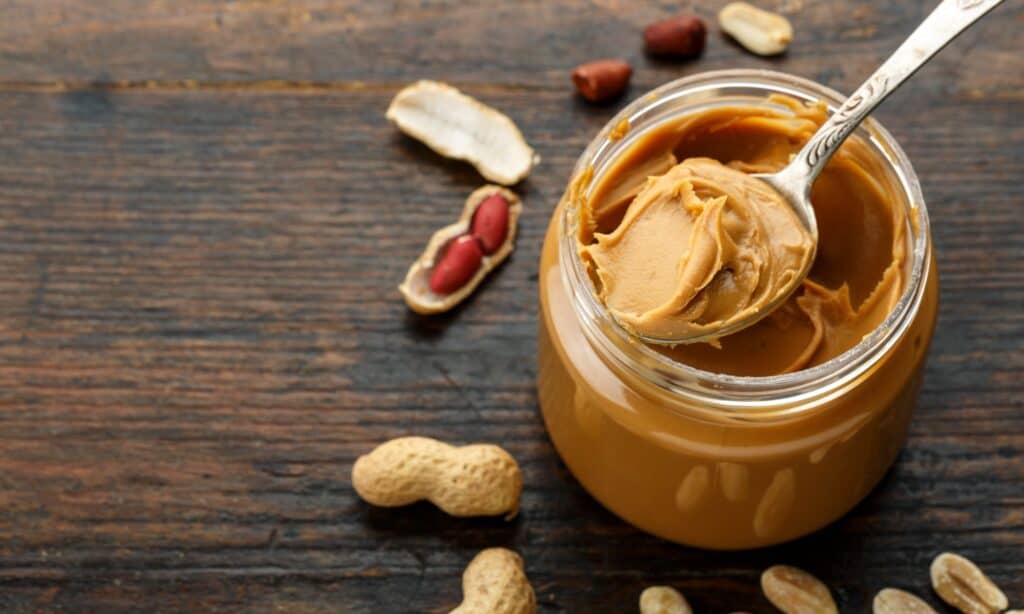
Peanuts can be eaten raw, boiled, or roasted and are used in a variety of culinary applications, such as peanut butter.
©iStock.com/Sanny11
How to Grow Peanuts: Choosing a Variety
There are several different varieties of peanuts. However, the most common types are Virginia, Spanish, and runner peanuts. Virginia peanuts, also known as large peanuts, have a bold, crunchy texture and are often used for roasting and making peanut butter. Spanish peanuts are smaller and have a sweeter flavor. They are typically used for making peanut oil, candy, and snacks. Runner peanuts are known for their high yields and are grown commercially for peanut butter production. They are well adapted to a variety of growing conditions and are grown extensively in many countries, including the United States, Argentina, and China. There are also other less commonly recognized types of peanuts, including Valencia peanuts and Tennessee Red Valencia peanuts, which are sweet and are often used for roasting and boiling.
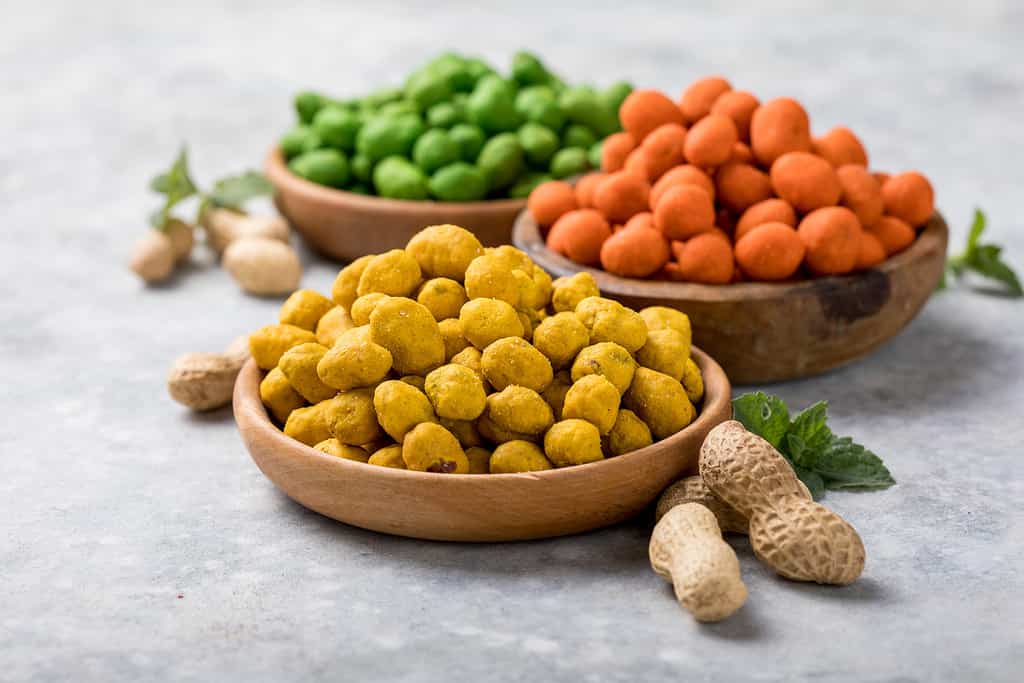
Spanish peanuts are smaller than Virginia peanuts and have a sweeter flavor. They are typically used for making peanut oil, candy, and snacks.
©Sokor Space/Shutterstock.com
How to Grow Peanuts: Planting
For the average gardener, planting peanut seeds is the easiest and most practical method of growing peanuts. Peanut seeds are readily available in gardening centers and online, and they are easy to plant and care for. It is possible to propagate peanuts through stem cuttings, but it is not a common practice for individual gardeners. Propagation is more commonly used by researchers or commercial growers who are interested in producing new varieties of peanuts through hybridization or cloning. For our purposes, we will concentrate on growing peanuts from seed.
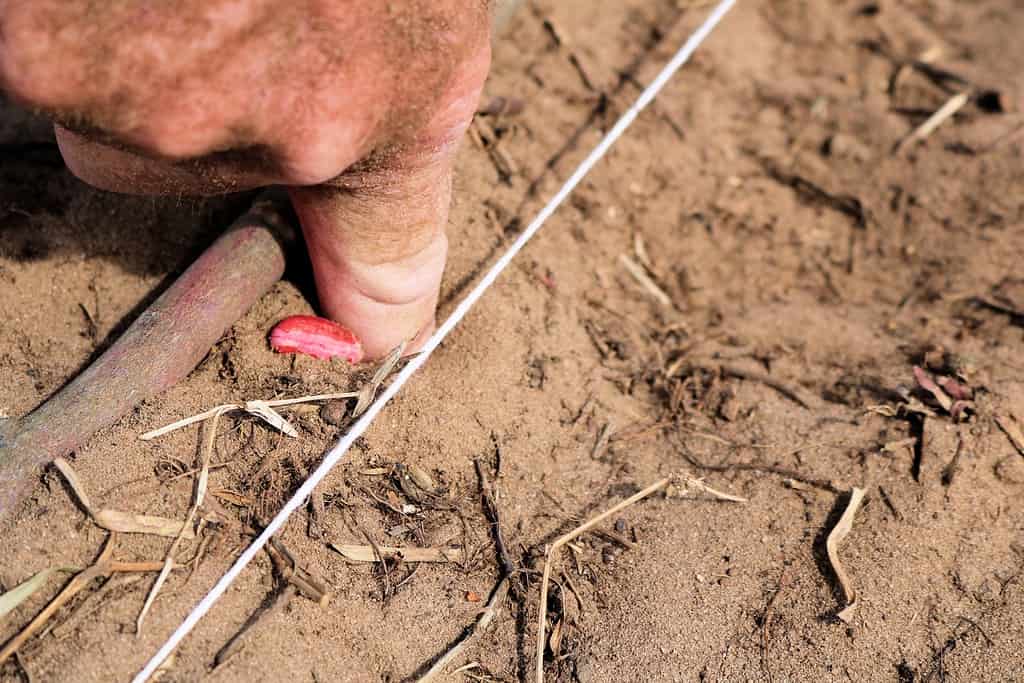
For the average gardener, planting peanut seeds is the easiest and most practical method of growing peanuts.
©TAMMY M JOHNSON/Shutterstock.com
How to Grow Peanuts: Selecting a Location
The perfect location for creating a peanut bed is a warm and sunny spot that receives at least 6 hours of direct sunlight per day. The soil should be well-drained, loose, and sandy. Peanuts do not grow well in heavy or compacted soils, as these can cause the developing pods to be deformed. The ideal soil pH for growing peanuts is slightly acidic, between 5.8 and 6.2. Discover how to determine your soil’s pH level here.
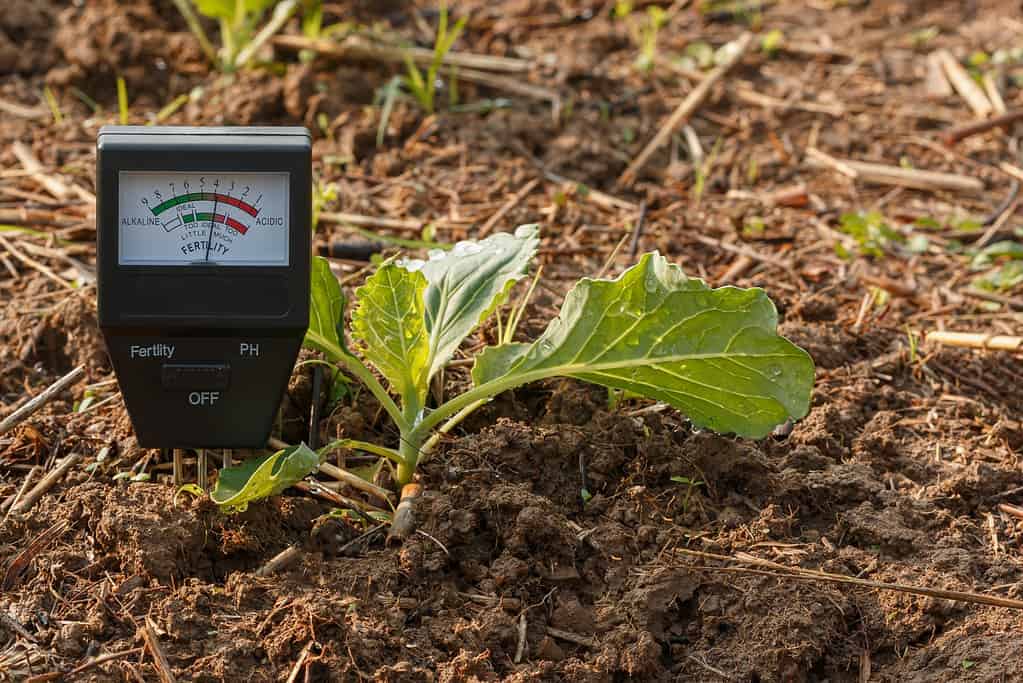
The ideal soil pH for growing peanuts is slightly acidic, between 5.8 and 6.2.
©chaphot/Shutterstock.com
The location should also be sheltered from strong winds, as peanut plants have shallow roots and can be easily uprooted. Ensure that the area is free from weeds, rocks, and other debris that could impede plant growth. Planning ahead: It’s important to rotate the location of the peanut bed to prevent the build-up of soil-borne diseases and pests. A three-year rotation is recommended to help maintain soil health and prevent disease.
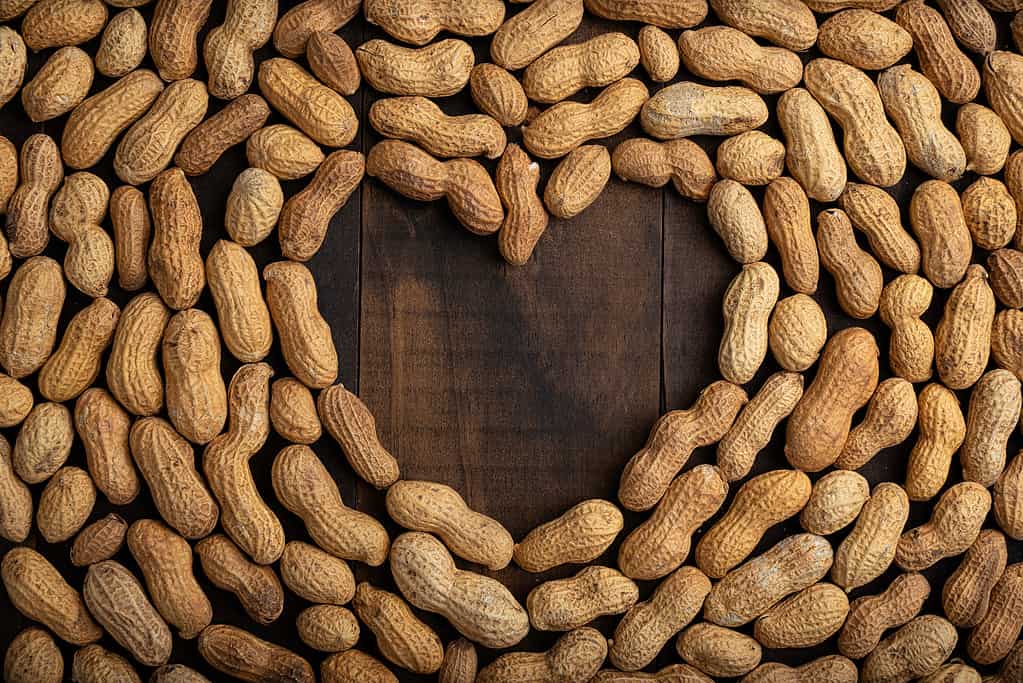
If you love your peanut crop. you’ll rotate the bed every three years to maintain its health.
©Sergio Hayashi/Shutterstock.com
Space Requirements
You need not devote an enormous amount of space to growing peanuts. Even a small peanut bed can yield a significant harvest. Your space requirements are dependent on how many peanut plants you are growing. Peanuts are relatively small plants that don’t take up much space. They can be grown in small garden beds, or even in containers. Aim to plant peanuts at a density of 4 to 6 plants per square foot (900 cm²). A single peanut plant can produce up to 50 delicious nuts, so you can expect to harvest 200-250 peanuts per square foot (900 cm²).
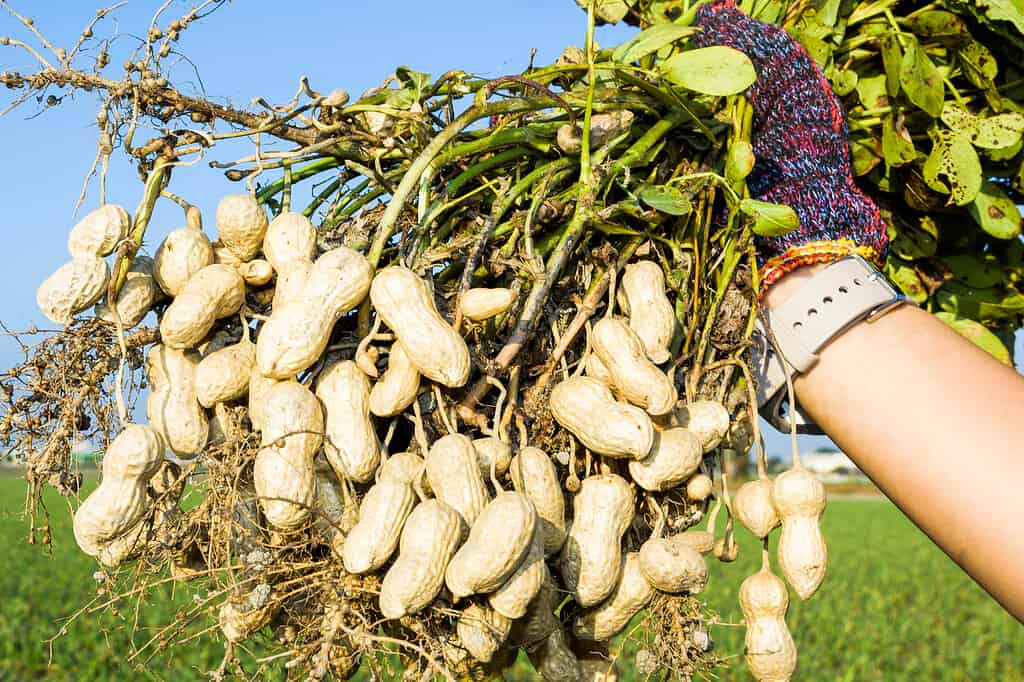
A single peanut plant can produce up to 50 delicious nuts, so you can expect to harvest 200-250 peanuts per square foot (900 cm²).
©Jack Hong/Shutterstock.com
How to Grow Peanuts: Preparing the Soil
Before planting, turn the bed by loosening the soil to a depth of at least 8 inches (20 cm) using a garden fork or spade. This helps aerate the soil, which aids growth. Once you have turned the bed, it’s time to amend the soil. Prior to the amendment process, determine your soil’s pH. Peanuts do best in slightly acidic soil. If your pH level is above 6, adding sulfur or peat increases acidity. If your numbers are too low, adding a bit of lime can pump them up. Once it’s been amended, use a garden rake to smooth the soil, so that you will have a level plane in which to plant your peanut seeds. Finally, water the soil, spraying it with a garden hose to allow the amendments to settle.

Before planting, turn the bed by loosening the soil to a depth of at least 8 inches (20 cm) using a garden fork or spade.
©Singkham/Shutterstock.com
How to Grow Peanuts: Planting the Peanuts
The time for planting peanuts is in the spring after the danger of frost has passed. If you’re unsure of the last potential frost date in your area, you can find it here. Proceed by digging a shallow furrow 2 to 3 inches (5-7 cm) deep and place the seed peanuts 6 to 8 (15-20 cm) inches apart, with the pointed end facing downward. Cover the peanuts with soil and water gently. Keep the soil moist throughout the growing season. This can be achieved by watering deeply once or twice a week, weather dependent.

Once planted, a peanut will sprout within 10 days.
©Stock2468/Shutterstock.com
How to Grow Peanuts: Weeding
Peanuts are low-growing plants that easily get lost in taller growing weeds when the garden is not tended regularly. Peanuts grow close to the ground, with their leaves and stems spreading out horizontally instead of vertically. They typically grow to a height of no more than 2 feet (60 cm), which is much shorter than many common garden weeds. Taller weeds can easily grow up and over the peanut plants, blocking out sunlight and depriving the peanuts of the nutrients they need to grow and develop properly. Therefore, it is important to keep the garden well-maintained by removing weeds and any other unwanted vegetation routinely.
This is most efficiently accomplished through hand-weeding through hoeing or using a garden cultivator and also acceptable methods. Mulching around the peanut plants can also help to suppress weed growth and conserve moisture in the soil. Regularly inspecting the peanut plants for signs of disease or damage is also important. This can be done by eyeballing the leaves, stems, and pods for any abnormalities. Any diseased or damaged plants should be removed immediately to prevent further spread.
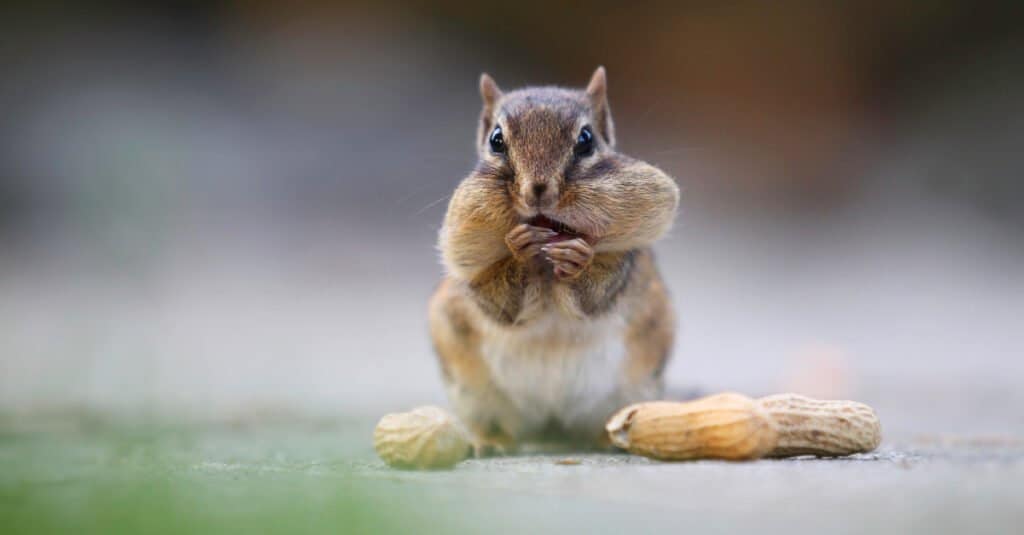
Humans aren’t the only animals that love peanuts!
©iStock.com/flySnow
How to Grow Peanuts: Harvesting
Peanuts are ready to harvest when the leaves turn yellow and begin to wither. From the time the seed is planted, peanuts take from 130 to 160 days to mature. Harvesting peanuts involves digging up the plants and allowing them to dry in the sun until they are completely dry. Depending on weather conditions, this process can take as long as three weeks.
The process of drying the peanuts is called curing. Once the peanuts have cured, remove any lingering garden soil by gently shaking or brushing the peanuts. Next, separate the peanuts from the plant. This is achieved by grasping the plant in one hand, and carefully pulling off the peanuts with the other. after all of the peanuts have been detached, dispose of the remaining plant matter, optimally by composting it. Give the nuts a final inspection and cleaning before storing them in a cool, dry place. Peanuts have a shelf life of 4 months. When refrigerated, they will keep for 1 year.
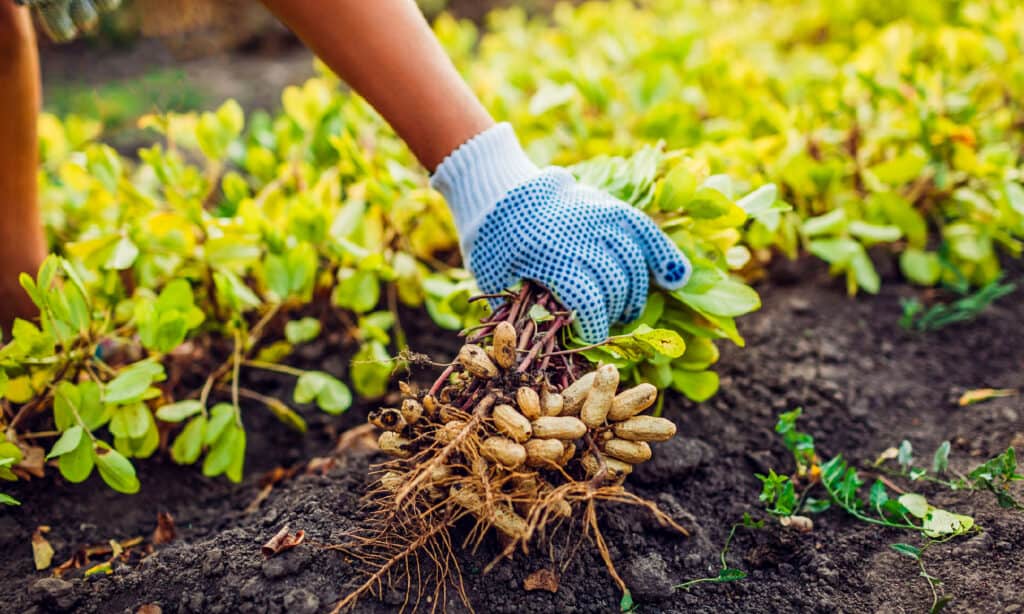
Peanuts are ready to harvest when the leaves turn yellow and begin to wither.
©iStock.com/Maryviolet
How to Grow Peanuts: Container Planting
There are no major differences in growing peanuts in a container vs. in the ground. The primary consideration is having adequate depth for the peanuts to develop in the container. Planters should have a minimum depth of 18 inches (45 cm). Once you have chosen a container, follow the above directions for planting your peanuts. Placing your container on a rolling base makes it easy for your peanut plants to reap the benefits of full sun. Ultimately, the choice of growing peanuts in the ground or in a container depends on personal preference and available space.
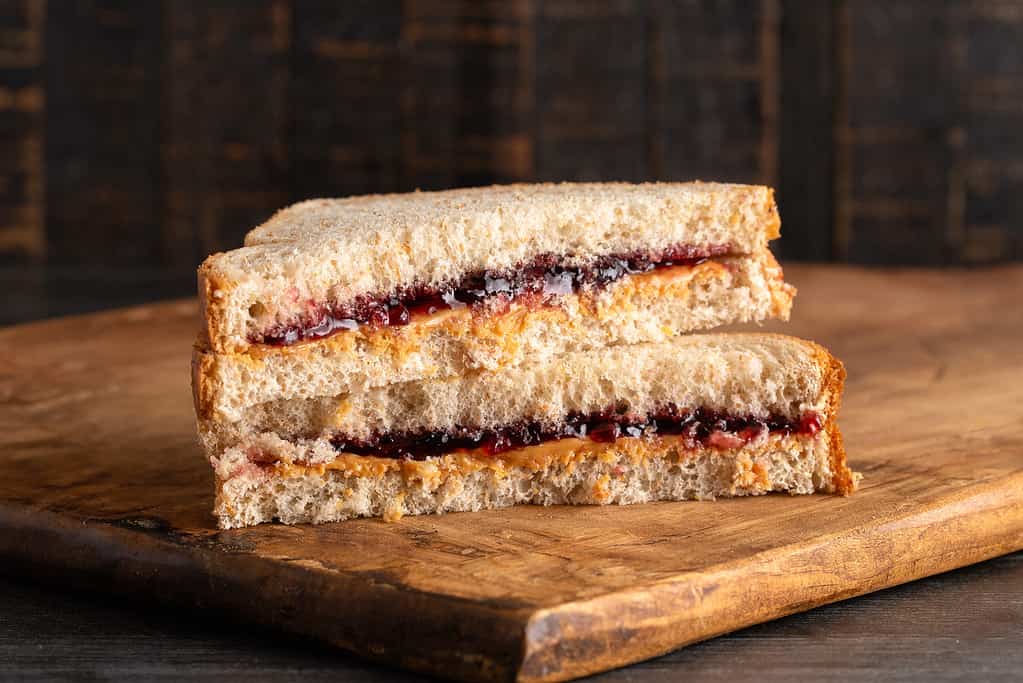
Sometimes all you want for lunch is a peanut butter and jelly sandwich. — Horror author Stephen King, March 30, 2022
©P Maxwell Photography/Shutterstock.com
Five Fun Facts about Peanuts
- Peanuts are indigenous to South America, specifically to the region that is now Peru and Brazil.
- George Washington Carver, an American scientist, is often credited with popularizing the use of peanuts in the United States. He discovered over 300 uses for peanuts, including peanut butter, soap, ink, and paint.
- The city of Dothan, Alabama, USA, is known as the Peanut Capital of the World and hosts an annual National Peanut Festival. The annual event has been held in early November since 1938.
- The average American consumes over six pounds of peanuts and peanut products each year.
- Peanuts are a sustainable crop because they are nitrogen-fixing, meaning they convert atmospheric nitrogen into a form that they use for growth.
Thank you for reading! Have some feedback for us? Contact the AZ Animals editorial team.








